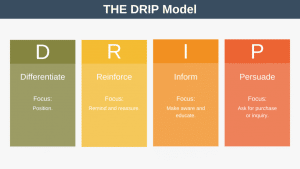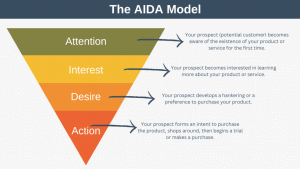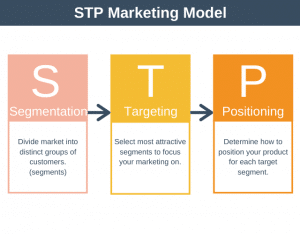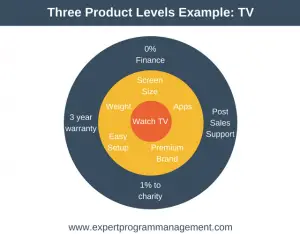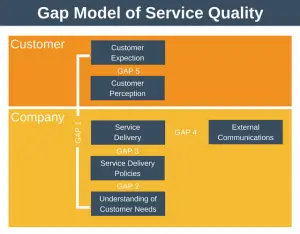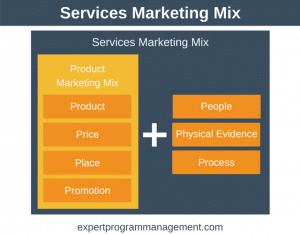The Product Life Cycle is a conceptual marketing concept. It shows the stages a product goes through from when it is first introduced to the market until it is removed.
Not all products make it through all stages of the life cycle. In fact, many products don’t even make it past the first stage of the Product Life Cycle. This means some products fail but others go on to perform exceptionally well.
What is a Product?
A product is anything that meets the needs of a customer. The definition of products thus encompass both:
- Physical products: Such as TV’s, cell phones, and cameras etc.
- Services: such as insurance, and healthcare etc
The Product Life Cycle
The Product Life Cycle is shown in the diagram below.
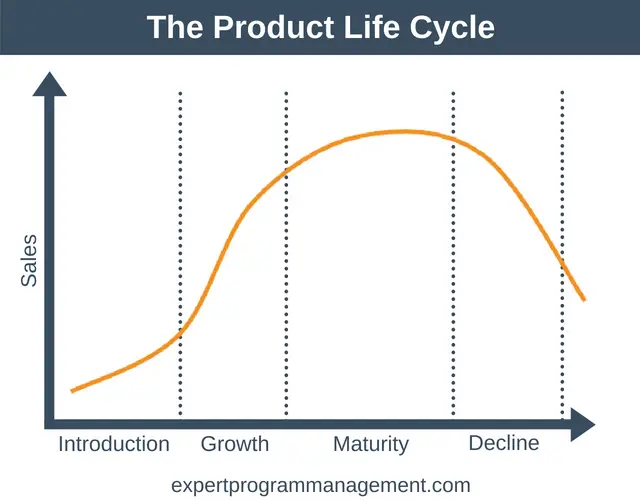
The stages of the Product Life Cycle are:
1. The Introduction Stage
In the introduction stage, when a product is first introduced to the market, sales will be low.
There can often be large costs involved in this stage which far exceed sales. For example, consider a pharmaceutical company bringing a new drug to market. Sales will be zero despite huge research and development costs until the drug is approved and sales begin.
This stage is typically characterized by negative cash flow, low sales, and high unit cost. High unit cost applies especially to physical products. For example, if you run a factory then your utilization of that factory will be low while sales are low.
The marketing cost per sale alone can often result in negative cash flow. This happens when a business invests heavily to make its potential customers aware of the product.
Introduction Stage Strategies
There are many strategies you can use to help encourage early adoption of your product:
- Use a large advertising budget to build awareness of your new product.
- Focus on a single distribution channel. In the introduction stage, you often don’t know the best way to market your product. Until you do, it can make sense to focus on a single distribution channel. You may even wish to bypass intermediaries in the early stages. You could do this by selling directly to your existing customer base.
- Get your pricing strategy right. Introduction stage products will typically use a:
- Skimming pricing strategy (high price) to capture high-value customers or a
- Penetration pricing strategy (low price) to sell as much as possible.
2. The Growth Stage
Not all products make it past the introduction stage but those that do will enter the growth stage.
This stage is identified in the model by a rapid growth in sales. In fact, in this stage sales grow faster than at any other stage in the Product Life Cycle.
The costs incurred start of fall away during this stage as research and development work is minimal. Additionally, economies of scale kick in as volumes rise. As a result of costs decreasing and sales rising, profits begin to rise or at least get closer.
It is typically during this stage that competitors begin to enter the market. They see the growth being experienced and want a piece of the action. The introduction of competitors results in price reductions as consumers have more choice.
Growth Stage Strategies
Different strategies are required during the growth stage as you try to drive market penetration and maximize your market share.
- Widen your target customer base to increase your total addressable market.
- Increase your distribution channels.
- Make enhancements to the product, for example, by adding new features. These enhancements are not a one-time event. It is a continuous process of product improvement to try and sustain your high-growth for as long as possible.
3. The Maturity Stage
This rapid sales growth can’t continue forever. Eventually, every product will enter the maturity stage.
Counterintuitively, this is the stage when the most profit is earned by those with the dominant market share, the market leaders. There are a few reasons for this:
- Weaker players start to leave the market.
- Less investment and marketing is required to maintain sales.
- Companies get efficient through better processes and economies of scale, resulting in lower unit costs.
During this stage is when the most revenue is earned by the market as a whole. But, as the market isn’t growing, firms fight to maintain or grow their market share.
They do this by emphasizing the unique features of their product or brand. During the maturity stage, the market starts to become saturated. Despite the sales volume reaching its greatest, profits eventually begin to decline as competition is so intense and products/services become commoditized.
Maturity Stage Strategies
If you have a dominant market position, then the key goal of this stage is to maximize the return on your product.
- Your promotional activities should focus on what makes you unique (your unique selling point).
- You should maximize the number of distribution channels you use.
- Maximize the customer segments you offer the product to.
- Investigate ways to extend the maturity phase of the life cycle (we cover techniques for doing this later in this article).
- Manage capacity and inventories in such a way as to maximize profits.
4. The Decline Stage
This is the final stage in the Product Life Cycle and it is characterized by falling sales as the market begins to shrink.
In this stage, unit costs start to rise again as economies of scale erode. This combined with a sales decrease means profitability begins to wane.
In this stage, the market is saturated. There is excess capacity, and competitors begin to rapidly exit the market.
There are many reasons why products enter the decline stage. The most common one is technological advancement. Just look at how streaming movies has replaced DVDs. Another common reason is changing consumer tastes.
Decline Stage Strategies
There are a few common strategies you can use to squeeze the final profit from your products in the decline stage.
- Cut marketing spend and R&D spend.
- Cut prices to maintain competitiveness.
- Consider offering the product only to a loyal niche segment.
- Discontinue the product. If the product is no longer profitable during the decline stage then you may want to discontinue it. It may also make sense to sell off any outstanding inventory or associated assets (e.g. machinery).
Product Life Cycle Extension Strategies
If you’re a dominant player in the market and your product is in the maturity phase then it is natural to want to extend this phase for as long as possible. This is because it is in this phase that the most profit is made.
In effect, these companies are trying to do what is depicted in the following diagram.
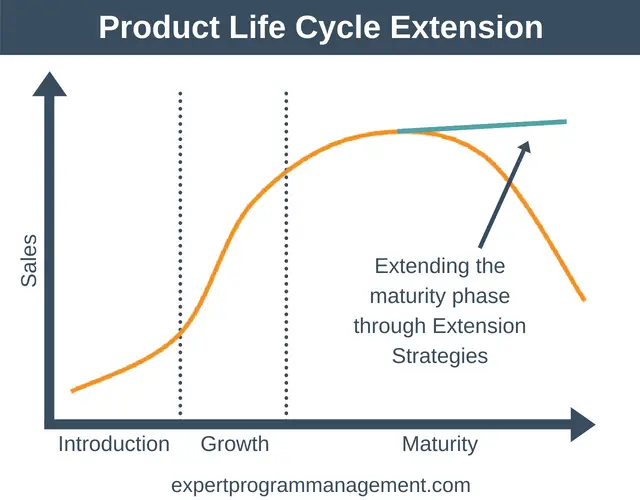
There are many Product Life Cycle extension strategies available to companies, including:
- Advertising: Try to find a new audience or reactive the interest of your previous audience.
- Finding new markets: Opening the product to new markets can extend its life.
- Reducing the price: This can make the product attractive to new people.
- Reposition the product: For example, a sugary sweet could be rebranded as a sports energy capsule!
- Add new features: To stay ahead of the competition, attract new customers, and reactivate old ones. Apple didn’t stop developing the iPhone after they released the first version.
- New packaging: For example, perhaps environmentally friendly packaging could attract new customers.
All these techniques will need advertising to become known. But the options to extend the lifetime of your product are only limited by your imagination.
Product Life Cycle Example
In this example, we’re going to look at two products that Apple launched at roughly the same time.
The first product is the Power Mac G4 Cube (launched in 2000), and the second is the iPod (launched in 2001).
Despite heavy investment, the G4 failed to make it past the introduction stage. Why? Because it was expensive. It didn’t come with a monitor, and manufacturing issues meant there were often cracks in the clear plastic case it came in.
Contrast this with the iPod.
It was also expensive, but it was hugely easier to use than competitors such as Sony’s Discman. It’s clean and unique design also made it highly desirable. These two factors combined to justify the price point.
Once customer awareness of the product began to spread through word of mouth and advertising, the iPod entered the growth phase. Here sales were rocketing.
Over time, however, the competition began to catch up and the maturity phase was entered. The price was reduced to maintain competitiveness, and capture new customers who were previously priced out. But economies of scale meant profitability was maintained.
Apple introduced updated products to extend the length of the maturity phase, maintain the high price-point, and recapture previous customers, such as an iPod with a color screen.
Eventually, though, the market began to shrink as people switched to using their smartphones to listen to music. This is the decline phase where competitors rapidly left the market.
Other Tools
Other tools and models you may find useful to use alongside the Product Life Cycle include:
– The 4 P’s of Marketing: Can help you get the marketing aspects right for each stage of your product.
– The Boston Matrix: Can help ensure your company has a balanced portfolio of products across the different life cycle stages. You’d obviously have a major problem if all your products were about to enter the decline phase at the same time.
Conclusion
Using The Product Life Cycle to understand how products change over time can help you make better marketing decisions.
All products begin life in the introduction phase of the Product Life Cycle. Not all products make it beyond this stage but those that do enter the growth stage. This stage identified by rapid sales growth.
Eventually, a market becomes mature and sales begin to slow. This is the maturity stage. Although strategies and tactics exist to extend the mature stage, eventually this stage also comes to an end and the product enters the decline stage.
During the decline stage, sales are falling quickly and competitors leave the market rapidly. Eventually, most products end their life being removed from the market altogether.

